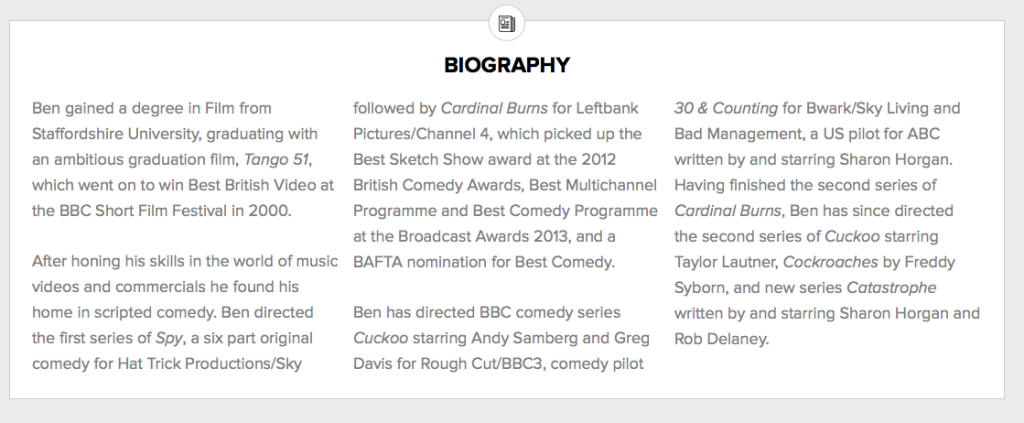Click here to go back to Website – Main Menu
Your client’s biography is your first opportunity to get across the essential details of their background and success to date. It is for this reason that you must get the content on this page perfect – think of it as your shop window.
A client’s profile will continually evolve as their careers progresses and therefore you will need to constantly monitor and change or add to the profile on a regular basis to make sure they are up-to-date.
There are three types of biography on the website SUMMARY BIOGRAPHY, LOGLINE and BIOGRAPHY
SUMMARY BIOGRAPHY
Used by Books, TFTV and Presenters the Summary Biog should be a simple and short statement/description of the client’s job:
LOGLINE
The Logline is used by the Acting department in place of a Summary Biog. It should be a one (very occasionally two) sentence description that succinctly sums up the status of the client, what they are working on, what you can currently see them in, best known for etc.
BIOGRAPHY
A good biography should be at least 100-150 words, but can be up 300-400 words long for established clients with a rich career history.
Anything less than 100 words then you shouldn’t be publishing the biog on the page until you have added more content and edited. Or look at using alternatives such as Summary Biog or Fast Fact. Anything longer should ideally be edited down.
This example is the ideal length:
BIOGRAPHY STRUCTURE
To write a good biography, start by telling the reader the most important details about the client, followed by the most essential supporting information, and end by giving further background detail about your client.
Introduction: State the client’s full name. What are they best known for?
Paragraph 2: A summary of their best-known works, awards/prizes won, key successes, best sellers, ratings hit, critical acclaim, etc.
Paragraph 3: Provide related background education, how they launched their career, training, study, education, other skills, areas of work/note.
Conclusion: Other works, works in development, coming soon, projects to look forward to.
For writer clients there is a preference for using the ‘About the Author’ blurbs from their novels. This format is fine to use as it follows an industry standard, and as long as it is long enough (100-150 words) it is ok to use. However these blogs can be too brief and perfunctory and do not always work on our website. Like this example:
In which case you should add more detail or use alternative modules such as Fast Fact or Summary Biog to publish this information instead.
In summary:
ALWAYS USE GOOD GRAMMAR AND PUNCTUATION AND ASK SOMEONE TO PROOF YOUR COPY


